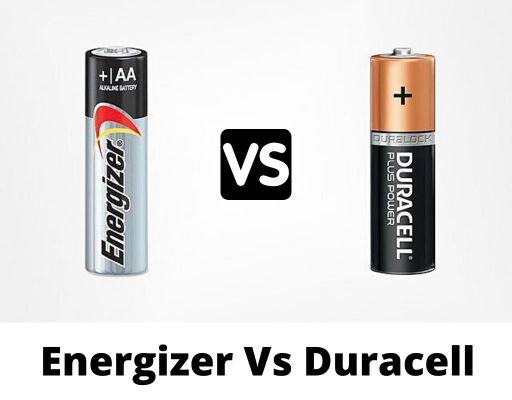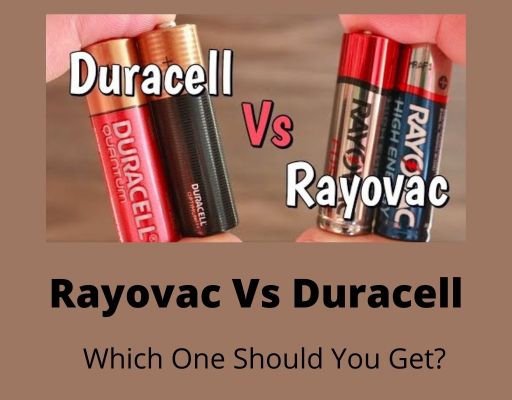A D battery is a dry cell of a specified size with an electrical contact on either end. These 1.5V batteries are most commonly seen in items that require a long runtime.
Flashlight batteries were often known as D cells. Flashlights, towel dispensers, radio communication, and transmitters all need these batteries.
Depending on the technology, a 9V battery produces a voltage of 7.2 to 9.6 volts. The PP3 size is a pretty frequent one. This battery is made up of six 1.5 V LR61 cells that are encased in a wrapper.
Smoke alarms, test and instrumentation equipment, LCD screens, medical gadgets, and commercial properties all need nine-volt batteries.
Read on carefully to learn more about the D and 9V batteries and their differences.
D vs 9V Battery: Quick Comparison Table
Apart from the voltage, there are other important distinctions between a D battery and a 9V battery. Look at the table below to see the differences between the features.
| Features | D Battery | 9V Battery |
| Voltage | 1.5 Volts | 9 Volts |
| Battery Types | Lithium, Alkaline, Zinc Carbon, Lithium Iron Disulphide | Alkaline, Lithium, Zinc Air, Zinc Chloride, Silver Oxide, Lithium-Ion, LiFePO4, LiMn2O4, Li2TiO3, LiNiMnCoO2, LiCoO2 |
| Height | 58.0 – 61.50 mm | 46.40 – 48.50 mm |
| Length | 58.0 – 61.50 mm | 25.0 – 26.50 mm |
| Width / Diameter | 33.0 – 34.20mm (Diameter) | 15.0 – 17.50 mm (Width) |
| Capacity | 10,000 – 20,000 mAh | 120 – 1200 mAh |
| Applications | Hearing Aids, Watches, Electric Keys, Flashlights, etc. | Walkie-Talkies, Smoke Alarms, Patient Monitors, Emergency Beacons, etc. |
| Cost | $1.0 – 2.0 | $1.6 – 3.0 |
| Lifetime | 2 – 3 Years | 1-5 Years |
What Are the Difference Between D Battery vs 9V Battery Based on Features?
Voltage:
The D-type battery provides 1.5 voltages. Has a stable performance with its flat discharge curve.
The 9V battery provides voltage ranging from 6.5V to 8.4V. The difference in voltages depends on the cell chemistry.
Pressure or momentum is the same thing as voltage. If you need more voltage, the 9V battery is significantly more efficient than the 1.5 volt D type battery.
Battery Types:
The D battery types are lithium, alkaline, zinc-carbon, and lithium iron disulfide (LiFeS2). The only cells that are completely disposable are Zinc Carbon and LiFeS2.
Primary cells are lithium, zinc-air, alkaline, silver oxide, and alkaline. Rechargeable ones are alkaline, Li-ion, LiFePO4, LiMn2O4, Li2TiO3, LiNiMnCoO2, LiCoO2, NiCad, NiMH, and Lead Acid.
The various chemistries each have their own set of properties. The best battery chemistry is Li-ion, Lead Acid, LiFePO4, NiCad, and NiMH. So, the 9V is better.
Dimensions:
The shape of the D-type batteries is cylindrical. The height or length is 58.0 to 61.50 mm with a diameter of 33.0 to 34.20 mm.
The 9V batteries are cubic with round edges. The height, length, and width are 46.40 to 48.50 mm, 25.0 to 26.50 mm, and 15.0 to 17.50 mm respectively.
The type D batteries are bigger in shape and provide less voltage than the 9V batteries.
Capacity:
The capacity of D batteries depends upon the current draw. Approximately, the capacity is 20,000 mAh at 25 mA draw, and 10,000 mAh at 500 mA draw.
Different chemistry types of 9V batteries have different capacities. These are in mAh: Alkaline (550), Zinc-Carbon (400), Lithium (1200), NiCd (120), NiMH (175 – 300), Lithium Polymer (520), Li-ion (620), etc.
If you want more capacity, the D-type battery can provide you with more current flow than the 9V ones.
Applications:
Generally, type D batteries are used for flashlights, radios, smart watches, Bluetooth equipment, kid’s toys, sports shoes, and so on.
9V batteries have many uses. Transistor radios, clock radios, electric guitars, alarm clocks, smoke alarms, LCDs, and other devices use these batteries.
If the device needs power for a long time such as 24 to 48 hours, D types are the best choice.
Lifetime:
The Type D battery will last around 15 hours if utilized at a consumption rate of 500 mAh. The battery will then need to be replaced or recharged. If rechargeable, it may last 2 to 3 years.
Lithium 9V batteries may last up to 5 years while alkaline 9V batteries will last up to one to two years. The rechargeable batteries might drain every four to eight hours.
So, if you want more lifetime, you should get lithium 9V batteries. If you want more power from a single charge, you should get type D batteries.
D Battery or 9V Battery: Which One to Choose, Finally?
The choice is based on many factors. If the gadget you’re using the battery on has a lengthy runtime, you should go for a D-type battery.
The primary D-type batteries have high specific energy and long storage duration. These are also inexpensive and require little upkeep. Furthermore, they are eco-friendly.
The 9V batteries are smaller than the 12V ones. If the appliance is tiny and requires a smaller battery, the 9V battery should be used. These are also compatible with a wide range of electronic gadgets.
So, the answer is dependent on your requirements.
Type D is preferable to 9V if you require more capacity.
However, if you want a greater voltage, a 9V battery is recommended than a type D cell.
Frequently Asked Questions (FAQs):
u003cstrongu003eWhat is equivalent to a 9V battery?u003c/strongu003e
The best equivalent batteries to a 9V battery are 1604A, 1604M, 6LR61, 6F22, 6KR61, 1604LC, MN1604, PP3HP, 006P, AM6F, and 7.2H5.
u003cstrongu003eWhat is equivalent to a type D battery?u003c/strongu003e
The best equivalent batteries to atype D battery are MN1300, BA-30, LR20, R20, MX1300, 13A, 13D, and type 373.
u003cstrongu003eWhich 9V battery has the highest typical capacity?u003c/strongu003e
The primary lithium 9V non rechargeable battery has the highest typical capacity which is 1200 mAh.
u003cstrongu003eWhich type D battery has the highest typical capacity?u003c/strongu003e
The Li-FeS2 type D battery has the highest capacity of 18-24 Ah. These are non-rechargeable with 1.8 nominal voltage.
u003cstrongu003eMy Recommended Type D and 9V Batteriesu003c/strongu003e
There are many batteries available on the market. Take a look at the list below to get the best type D and 9V batteries.
Type D Battery:
Duracell Coppertop All-Purpose Alkaline D Battery
– General-purpose batteries for household and office devices.
– Can be used in toys, remotes, clocks, portable electronics, etc.
Rayovac Fusion Premium Alkaline D Cell Batteries
– Low drainage on ANSI average performance test.
– Can hold power for up to 12 years in storage.
9V Battery:
Energizer Long-Lasting Alkaline 9 Volt Power Batteries
– Chemical system is Zinc-Manganese Dioxide (Zn/MnO2).
– Best for clocks, toys, thermometers, etc.
PKCELL Maximum Power 9 Volt Dry Battery
– Capacity is 240 minutes at 180 ohms with 3 years shelf life.
– Zinc Manganese Dioxide chemical system with CE, RoHS, and MSDS certificate.
Summary
I’ve given you a variety of knowledge on type D and 9V batteries. Both have their strengths and weaknesses. Type D has a higher capacity, but 9V has a higher voltage.
If you are buying a battery for a device, you should consider the voltage, capacity, dimensions, and price of the battery.
I have also listed several best-selling products on the market for you to consider. Hopefully, after reading this post, you will be able to select a battery that meets your requirements.


